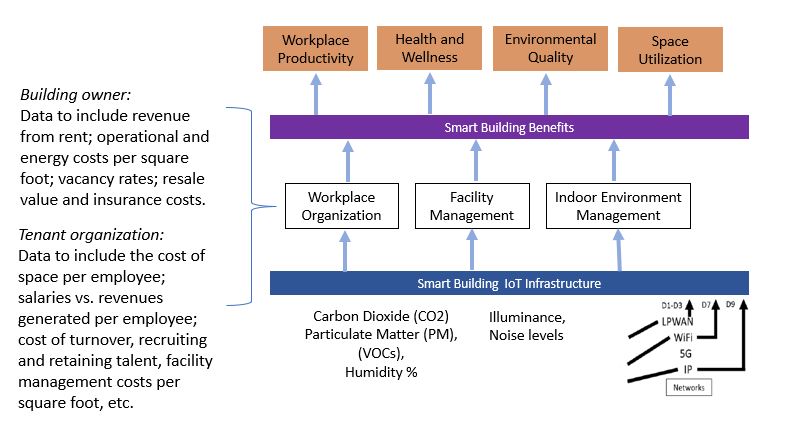Organizational and Individual Productivity and Wellness of Smart Buildings: Difference between revisions
No edit summary |
No edit summary |
||
| Line 57: | Line 57: | ||
===What are the indoor environmental quality KPIs?=== | ===What are the indoor environmental quality KPIs?=== | ||
Indoor Environmental Quality (IEQ) is a broad term that encompasses several different aspects of the built environment. Key Performance Indicators (KPIs) for Indoor Environmental Quality can cover several areas, including air quality, lighting, thermal comfort, acoustics, and ergonomics. The specific KPIs that are relevant can vary depending on the type of building and its occupants. Here are some of the key KPIs in each area: | Indoor Environmental Quality (IEQ) is a broad term that encompasses several different aspects of the built environment. Key Performance Indicators (KPIs) for Indoor Environmental Quality can cover several areas, including air quality, lighting, thermal comfort, acoustics, and ergonomics. The specific KPIs that are relevant can vary depending on the type of building and its occupants. Here are some of the key KPIs in each area: | ||
# Air Quality: | # Air Quality:# Numbered list item | ||
* Carbon Dioxide (CO2) Levels: High levels can cause discomfort and health issues. Recommended levels are usually below 1000 ppm (parts per million). | * Carbon Dioxide (CO2) Levels: High levels can cause discomfort and health issues. Recommended levels are usually below 1000 ppm (parts per million). | ||
* Particulate Matter (PM): PM2.5 and PM10 are commonly used metrics. Lower numbers are better. | * Particulate Matter (PM): PM2.5 and PM10 are commonly used metrics. Lower numbers are better. | ||
| Line 65: | Line 65: | ||
* Radon: This naturally occurring radioactive gas can accumulate in buildings. The occurrence of radon varies with the site geology but is should be evaluated and minimized. | * Radon: This naturally occurring radioactive gas can accumulate in buildings. The occurrence of radon varies with the site geology but is should be evaluated and minimized. | ||
* Biophilic Design: Incorporating elements of nature into the built environment can contribute to IAQ and improve well-being. | * Biophilic Design: Incorporating elements of nature into the built environment can contribute to IAQ and improve well-being. | ||
# Lighting: | # Lighting:# Numbered list item | ||
* Illuminance Levels: Measured in lux, with recommended levels varying depending on tasks performed. | * Illuminance Levels: Measured in lux, with recommended levels varying depending on tasks performed. | ||
* Glare: Should be minimized to prevent visual discomfort. | * Glare: Should be minimized to prevent visual discomfort. | ||
Revision as of 19:49, June 8, 2023
| Smart Buildings | |||||||||||
|---|---|---|---|---|---|---|---|---|---|---|---|

| |||||||||||
| Sectors | [[{{{sectors}}}]] "{{{sectors}}}" is not in the list (Buildings, Cybersecurity and Privacy, Data, Education, Public Safety, Rural, Smart Region, Transportation, Utility, Wellbeing, ...) of allowed values for the "Has sector" property. | ||||||||||
| Contact | Jiri Skopek | ||||||||||
| Topics | |||||||||||
Activities
Press
| |||||||||||
- Authors
This section explores the application of smart technologies in buildings to increase the ORGANIZATIONAL PRODUCTIVITY and WELLNESS of the various private/public sector stakeholders: the owners & investor organizations, property and facility management organizations, government and corporate tenants (i.e. organizations who occupy or rent space) and individual occupants.
The respective parts of the document consist of the following:
- The Benefits of Organizational and Individual Productivity and Wellness of Smart Buildings section identifies the productivity and health benefits of smart buildings to its occupants.
- The KPI section identifies the criteria by which Productivity and Wellness can be measured.
- Smart building technologies that will improve organizational productivity describe the various features and technologies further addressed in detail in the section.
- Finally Case studies section provides examples of the GECB implementation.
Benefits of Organizational and Individual Productivity and Wellness
In the post-COVID era, the commercial real estate (CRE) sector is facing several key problems and challenges:
- Reduced demand: The pandemic has disrupted various industries, leading to downsizing, closures, and work-from-home arrangements. This has resulted in reduced demand for office spaces, retail spaces, and other commercial properties. The shift towards remote work and e-commerce has impacted the need for physical space particularly in offices.
- Office space utilization: Many organizations have realized the effectiveness of remote work and adopted flexible work policies. As a result, companies are reassessing their office space requirements, leading to a potential oversupply of office spaces. This has put downward pressure on rental rates and occupancy levels.
- Repurposing and adaptive reuse: As traditional demand for certain types of commercial real estate declines, there is a need for creative solutions such as repurposing and adaptive reuse. Finding new uses for vacant or underutilized spaces, such as converting office buildings into residential or mixed-use developments, poses both challenges and opportunities.
- Health and safety concerns: The pandemic has raised concerns about health and safety in commercial properties. There is a greater focus on ventilation systems, touchless technologies, and sanitation practices to ensure the well-being of occupants. Implementing these measures can involve additional costs for property owners.
It's important to note that the specific challenges and their extent can vary across different regions, property types, and market conditions. While these problems pose significant obstacles, they also present opportunities for innovation, adaptation, and the reimagining of commercial real estate in the post-COVID era.
Here are some of the benefits of smart buildings on organizational and individual productivity and wellness:
- Workplace Productivity: Smart buildings can significantly support employee productivity, which can be linked to organizational engagement and well-being. Smart buildings can create meaningful customer interactions, enhancing the overall experience for visitors and employees alike Cisco Smart Building Solutions https://www.cisco.com/c/en/us/solutions/smart-building.html#~benefits .
- Health and Wellness: Smart buildings can optimize the wellness of indoor environments. Focusing on employee wellness is a sound business decision. This is because a comfortable and healthy working environment can improve employee satisfaction and lead to happier and more productive employees
- Better Environmental Quality: This includes improved indoor air quality, air filtration, lighting, water quality, and more, which directly impacts the health and well-being of occupants
- Space Utilization: Smart buildings can optimize space utilization, ensuring that the available space is used efficiently. This can lead to cost savings and improved productivity .
Figure 1: Relationship of the three H-KPI levels of the Productivity and Wellness of Smart Buildings ( In the web version clicking on the particular component of the diagram will take you to the relevant text section)
Definitions & KPIs of organizational and workplace productivity
Organizational Productivity: The National Library of Medicine defines "organizational productivity" as: The capacity of an organization, institution, or business to produce desired results with a minimum expenditure of energy, time, money, personnel, material11.
Simply put, it is a measure of how effectively an organization uses its resources to achieve its goals.
Organizational productivity is generally measured using a basket of metrics, sometimes measured in different units. These will vary depending on the type of organization. For a building owner’s organization, the basket of metrics could include revenue from rent; operational and energy costs per square foot; vacancy rates; resale value and insurance costs. For a tenant organization, the basket might include: the cost of space per employee; salaries vs. revenues generated per employee; cost of turnover, recruiting and retaining talent, facility management costs per square foot and so forth. It is by factoring all these metrics, that organizations determine their overall balance of costs and revenues.12
Workplace productivity is just one element of organizational productivity. It is defined as: The amount and quality of work accomplished in a work environment (for example, an office, a hospital or a restaurant) and how efficiently workers complete tasks at their workplaces.
Workplace productivity, like organizational productivity, is generally also measured using a basket of metrics, for example: the speed at which workers generate contracts and revenue; handle technical support calls for a tech firm; serve customers at a restaurant; produce a product at a factory; or come up with profitable innovations in addition to speed, the value of creative new ideas, problem resolution, and product designs. Keeping workplace productivity high helps an organization to reduce its costs, satisfy its stakeholders, expand its operations, and stand out in a competitive marketplace. By understanding common causes of low worker efficiency, it becomes possible to modify the workplace to streamline business processes and foster higher morale in the individuals that make up the workforce.
Workplace Productivity contributes to Organizational Productivity- Comparing the effect of various workplace strategies on worker productivity
A plethora of studies have demonstrated that the physical environment - that is to say, the form and function of the workplace – is a key determinant of workplace productivity, which, in turn leads to overall organizational productivity.
Like all organisms that thrive in their optimal environment, humans function better and our brains operate at their best in clean oxygenated air and certain thermal conditions of temperature, humidity and air movement. Just like every other species, humans need certain light conditions to trigger alertness and sleep and acoustic conditions that enable us to process information. We need hydration and nutrition and space to move. And we need to relax the body and periodically rest the mind13. For each of these physical factors, there are prescribed ranges under which the human body works better, and the brain operates at its best.14
What are the indoor environmental quality KPIs?
Indoor Environmental Quality (IEQ) is a broad term that encompasses several different aspects of the built environment. Key Performance Indicators (KPIs) for Indoor Environmental Quality can cover several areas, including air quality, lighting, thermal comfort, acoustics, and ergonomics. The specific KPIs that are relevant can vary depending on the type of building and its occupants. Here are some of the key KPIs in each area:
- Air Quality:# Numbered list item
- Carbon Dioxide (CO2) Levels: High levels can cause discomfort and health issues. Recommended levels are usually below 1000 ppm (parts per million).
- Particulate Matter (PM): PM2.5 and PM10 are commonly used metrics. Lower numbers are better.
- Volatile Organic Compounds (VOCs): These should be minimized as they can cause health problems.
- Humidity: Ideal levels are usually between 30% and 60%.
- Radon: This naturally occurring radioactive gas can accumulate in buildings. The occurrence of radon varies with the site geology but is should be evaluated and minimized.
- Biophilic Design: Incorporating elements of nature into the built environment can contribute to IAQ and improve well-being.
- Lighting:# Numbered list item
- Illuminance Levels: Measured in lux, with recommended levels varying depending on tasks performed.
- Glare: Should be minimized to prevent visual discomfort.
- Daylight Availability: Encouraging the use of natural light can improve mood and performance.
- Lighting Control: Allowing occupants to control lighting can improve comfort and satisfaction.
- Thermal Comfort:
- Temperature: Ideal levels depend on season, clothing, and personal preference, but generally between 68°F (20°C) and 78°F (25.5°C).
- Relative Humidity: Ideal levels are usually between 30% and 60%.
- Airflow: Good circulation can help maintain thermal comfort. Avoid drafts
- Acoustics:
- Noise Levels: Measured in decibels (dB), with lower levels generally being more comfortable.
- Reverberation Time: A measure of echo in a space. A shorter reverberation time is usually better for speech intelligibility.
- Sound Insulation: High levels can reduce noise transmission between spaces.
- Ergonomics:
- Furniture Design: Should support proper posture and reduce the risk of musculoskeletal problems.
- Layout: Should allow for easy movement and interaction with the space.
These physical environmental factors are observable and measurable, and their effect on brainpower output (productivity) has been well documented.15
Bad indoor air quality, thermal discomfort, noise and distractions, lack of daylight and poor visual ergonomics have a measurable negative effect on the productivity of individuals. For example, if we flush out carbon dioxide, and remove VOC pollutants from a workplace and in pump fresh air, – all else being equal, human brainpower improves measurably in terms of problem-solving, speed, and accuracy.16





